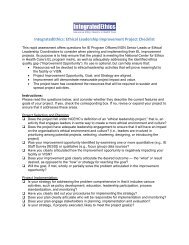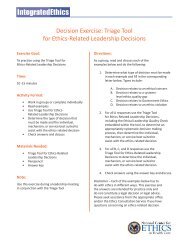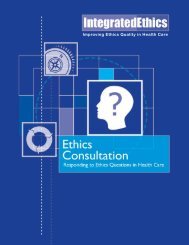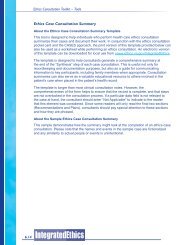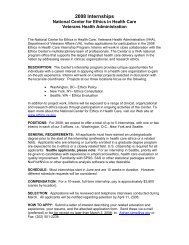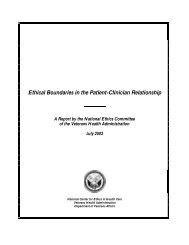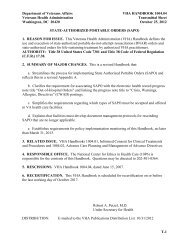Preventive Ethics - National Center for Ethics in Health Care - US ...
Preventive Ethics - National Center for Ethics in Health Care - US ...
Preventive Ethics - National Center for Ethics in Health Care - US ...
You also want an ePaper? Increase the reach of your titles
YUMPU automatically turns print PDFs into web optimized ePapers that Google loves.
Part II: Introduction to <strong>Preventive</strong> <strong>Ethics</strong><br />
Access<br />
The preventive ethics team learns about systemic ethics issues from its own ongo<strong>in</strong>g<br />
monitor<strong>in</strong>g and <strong>in</strong>put from <strong>in</strong>stitutional sources, <strong>in</strong>clud<strong>in</strong>g the Integrated<strong>Ethics</strong> Council, the<br />
facility ethics consultation service, senior leaders, service and program heads, and QM<br />
staff. The preventive ethics team should take steps to ensure that these groups are aware<br />
of the team’s existence, understand what the team does, and know how to refer issues to<br />
the team <strong>for</strong> consideration.<br />
Develop<strong>in</strong>g a referral network takes time and commitment—a one-time presentation, <strong>for</strong><br />
example, to a meet<strong>in</strong>g of senior leaders, isn’t sufficient. Establish<strong>in</strong>g rout<strong>in</strong>e communication<br />
with key <strong>in</strong>dividuals, services, and programs is crucial to develop<strong>in</strong>g and ma<strong>in</strong>ta<strong>in</strong><strong>in</strong>g<br />
a vibrant referral network. Participation by the <strong>Preventive</strong> <strong>Ethics</strong> Coord<strong>in</strong>ator <strong>in</strong> the<br />
facility’s Integrated<strong>Ethics</strong> Council will help to establish relationships and ensure regular<br />
communications with programs and offices across the <strong>in</strong>stitution. But the preventive ethics<br />
team should also consider rout<strong>in</strong>ely gett<strong>in</strong>g on the agenda at key meet<strong>in</strong>gs as part of<br />
ongo<strong>in</strong>g ef<strong>for</strong>ts to market preventive ethics. Potential referral sources will want to know<br />
what the team can do <strong>for</strong> them—and a powerful source of persuasion will be successfully<br />
completed ISSUES cycles and accompany<strong>in</strong>g storyboards.<br />
The preventive ethics team should also clearly understand that frontl<strong>in</strong>e staff across<br />
the organization can be a rich source of potential ethics quality issues. Supervisors<br />
and managers—from cl<strong>in</strong>ical services to the bus<strong>in</strong>ess office to human resources to<br />
ma<strong>in</strong>tenance—should encourage staff to share their ethical concerns so that managers<br />
can refer potential ethics issues to the preventive ethics team.<br />
A preventive ethics team shouldn’t be expected to act on every issue referred to it.<br />
<strong>Preventive</strong> ethics <strong>in</strong>volves prioritiz<strong>in</strong>g among the various ethics issues that need attention<br />
and address<strong>in</strong>g the highest priority issues first. The preventive ethics team should ensure<br />
that those who refer issues understand this. The team should also take care to “close the<br />
feedback loop” by <strong>in</strong><strong>for</strong>m<strong>in</strong>g requesters when or if the team will take action on a particular<br />
issue that has been referred to it. If the team doesn’t <strong>in</strong>tend to act, it’s important that it<br />
expla<strong>in</strong>s why and <strong>in</strong>dicate whether the issue might become a priority later.<br />
The preventive ethics team shouldn’t rely only on referrals to identify ethics quality issues,<br />
however. The team should go out and seek the most press<strong>in</strong>g issues from the virtually<br />
unlimited supply of quality improvement opportunities to be found <strong>in</strong> any health care<br />
organization. Also, through his or her position on the local Integrated<strong>Ethics</strong> Council the<br />
<strong>Preventive</strong> <strong>Ethics</strong> Coord<strong>in</strong>ator has an excellent opportunity to identify issues proactively—<br />
and to appreciate what issues most trouble leaders across the organization.<br />
Accountability<br />
Like any other important health care function, preventive ethics must have a clear<br />
system of accountability. Day-to-day responsibility <strong>for</strong> preventive ethics should rest with<br />
a designated <strong>in</strong>dividual, the <strong>Preventive</strong> <strong>Ethics</strong> Coord<strong>in</strong>ator. In the Integrated<strong>Ethics</strong> model<br />
(see Part I), this <strong>in</strong>dividual is accountable to the Integrated<strong>Ethics</strong> Program Officer, who is<br />
<strong>in</strong> turn accountable to the member of the facility’s top leadership (e.g., the facility director)<br />
who chairs the Integrated<strong>Ethics</strong> Council.<br />
The Integrated<strong>Ethics</strong> Council provides a mechanism <strong>for</strong> oversight of preventive ethics.<br />
The council is responsible <strong>for</strong> establish<strong>in</strong>g specific goals, structures, processes, and<br />
21



